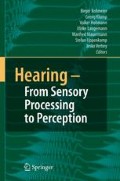Functional models of basilar membrane motion have a long tradition and a wide range of applications. They usually take as input the stapes vibration and provide the excitation pattern of the inner hair cells as an output. Even though the design of these models and the psychophysical data put into the model design are based on simple signals (e.g. sinusoids and twotone complexes), these models have the advantage to be also applicable to complex sounds (such as speech). Hence, they describe the degree to which we understand the response of the human peripheral auditory system to every-day sounds.
Access this chapter
Tax calculation will be finalised at checkout
Purchases are for personal use only
Preview
Unable to display preview. Download preview PDF.
References
Duifhuis H (1976) Cochlear nonlinearity and second filter: possible mechanism and implications. J Acoust Soc Am 59:408–423.
Duifhuis H (1980) Level effects in psychophysical two-tone suppression. J Acoust Soc Am 67:914–927.
Duifhuis H, Hoogstraten HW, van Netten SM, Diependaal RJ, Bialek W (1985) Modelling the cochlear partition with coupled Van der Pol oscillators. In: Allen JB, Hall JL, Hubbard AE, Neely ST, Tubis A (eds) Peripheral auditory mechanisms. Springer, Berlin Heidelberg New York, pp 290–297.
Goldstein JL (1988) Updating cochlear driven models of auditory perception: a new model for nonlinear auditory frequency analysing filters. In: Elsendoorn BAG, Bouma H (eds) Working models of human perception. Academic Press, London, pp 19–58.
Herzke T, Hohmann V (2005) Effects of instantaneous multi-band dynamic compression on speech intelligibility. EURASIP JASP 2005(18):3034–3043.
Meddis R, O’Mard LP, Lopez-Poveda EA (2001) A computational algorithm for computing nonlinear auditory frequency selectivity. J Acoust Soc Am 109:2852–2861.
Oxenham AJ, Plack CJ (1998) Suppression and the upward spread of masking. J Acoust Soc Am 104:3500–3510.
Talmadge C, Tubis A, Long GR, Piskorski P (1998) Modeling otoacoustic emission and hearing threshold fine structures in humans. J Acoust Soc Am 104:1517–1543.
Wersäll J, Flock A, Lundquist P-G (1965) Structural basis for directional sensitivity in cochlear and vestibular sensory receptors. Cold Spring Harbor Symp Quant Biol 30:115–132.
Author information
Authors and Affiliations
Editor information
Editors and Affiliations
Rights and permissions
Copyright information
© 2007 Springer-Verlag Berlin Heidelberg
About this paper
Cite this paper
Hohmann, V., Kollmeier, B. (2007). A Nonlinear Auditory Filterbank Controlled by Sub-band Instantaneous Frequency Estimates. In: Kollmeier, B., et al. Hearing – From Sensory Processing to Perception. Springer, Berlin, Heidelberg. https://doi.org/10.1007/978-3-540-73009-5_2
Download citation
DOI: https://doi.org/10.1007/978-3-540-73009-5_2
Publisher Name: Springer, Berlin, Heidelberg
Print ISBN: 978-3-540-73008-8
Online ISBN: 978-3-540-73009-5
eBook Packages: Biomedical and Life SciencesBiomedical and Life Sciences (R0)

